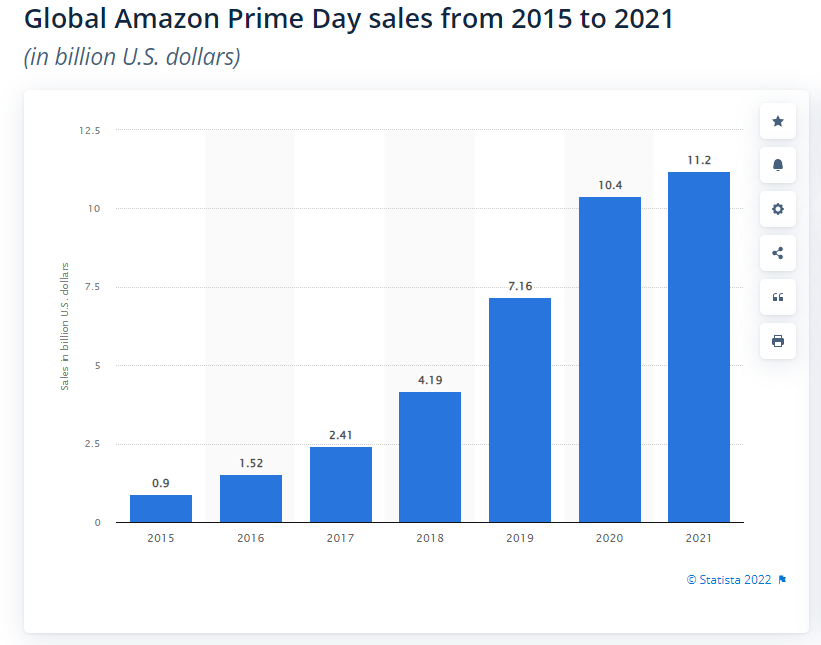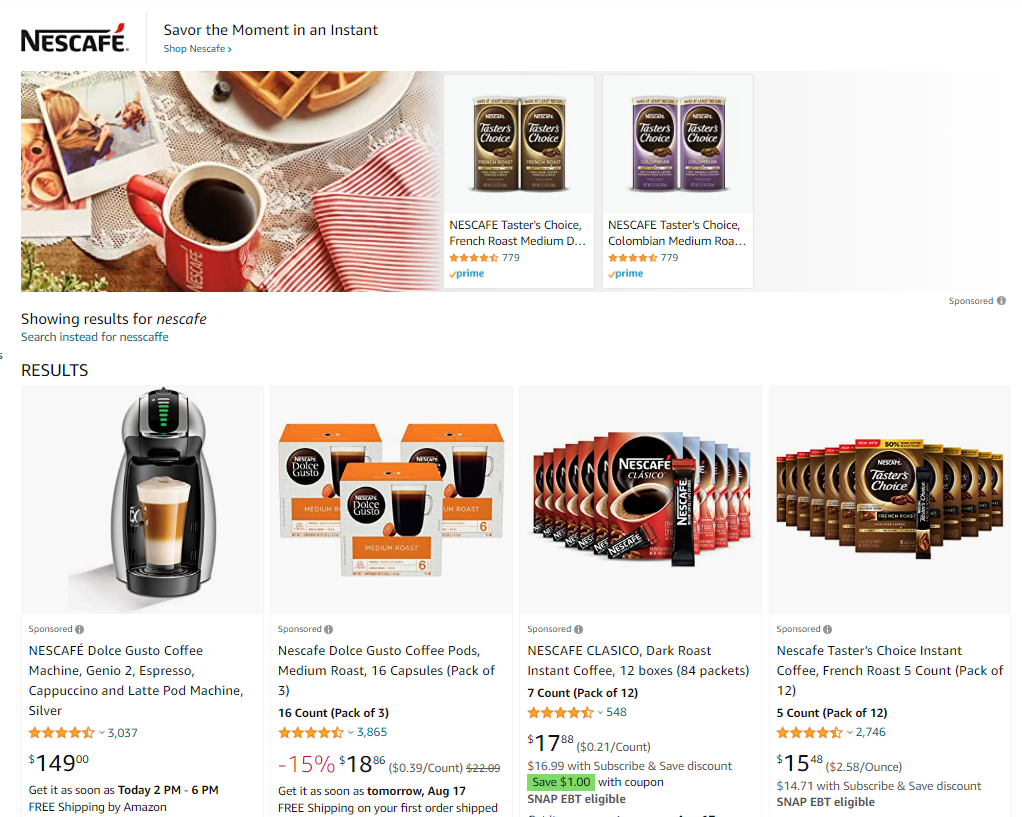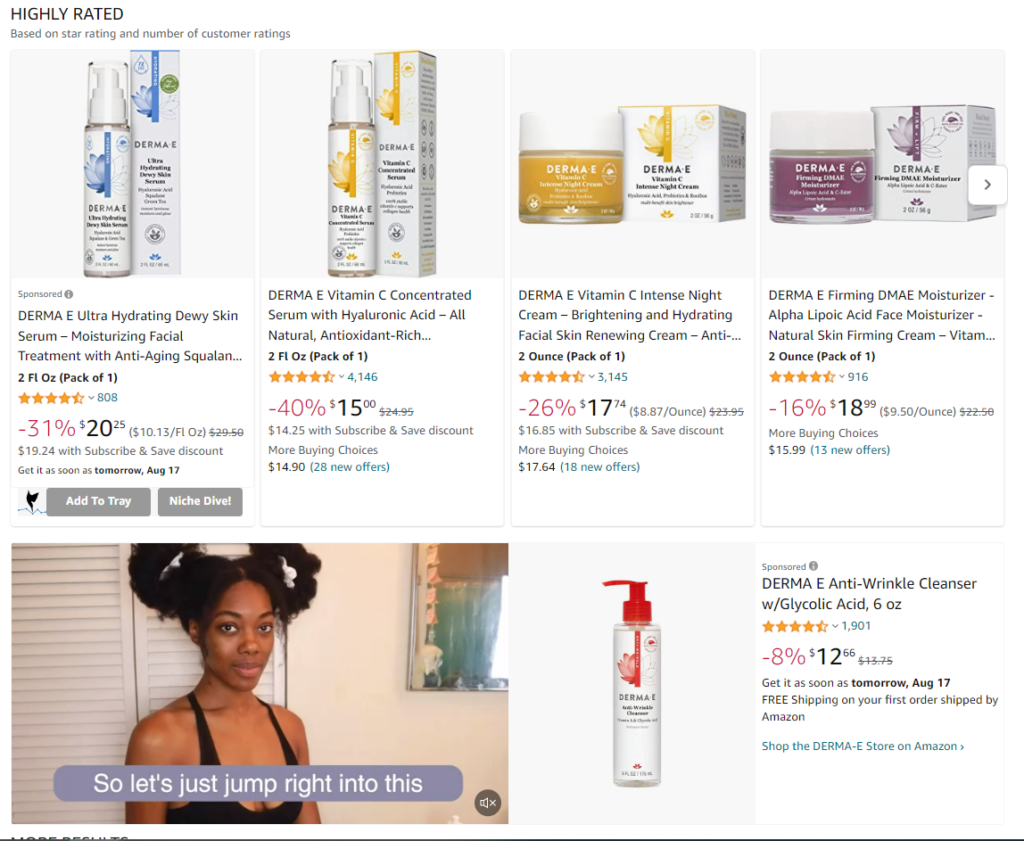
Prime Day has firmly established itself as a leading milestone throughout global e-commerce. Now in its eighth consecutive year, Amazon Prime Day 2022 covered more than 20 countries and offered steep one-off discounts across thousands of products and categories. With 66% of all US consumers ‘familiar’ with Prime Day and 81% of those respondents indicating that it increases their desire to shop, the new challenge for Amazon sellers is how to cut through the competition and convert the huge uptick in browsers amid fiercely competitive pricing.
Amazon advertising solutions enable small and large businesses to effectively target, communicate and convert according to a brand’s strategic priorities and resources.

Prime Day 2022
Since its inception, Prime Day’s colossal year-over-year (YoY) growth has led many eCommerce analysts to speculate over what contemporary factor could affect continued growth. While we believe that sales generated by Prime Day may cool year-over-year, now that participation has become essential for serious eCommerce brands, advertising is starting to play a more important role. With ad spending at $31.2 billion in 2021, up 58% from 2020, and ad revenue also jumping year-over-year, one thing’s for sure – a sophisticated advertising strategy is needed to stay competitive, especially before high-profit events such as Prime Day.
Despite rising inflation and an expected decline in consumer confidence and spending, we believe the two-day super sale has come at the right time for consumers motivated to take advantage of deals and savings. This offers Amazon sellers an opportunity to take advantage of the concentrated increase in demand and boost sales, protecting them from an expected lackluster fourth quarter.

Key Fundamentals – Retail Readiness
Make sure your non-PPC marketing efforts are worth the ad spend. Follow best practices that reflect your brand’s story and quality. Your brand’s Amazon storefront is your brick-and-mortar equivalent, so your product listings should be polished. These listings include:
Product titles
Optimize your character count to Amazon’s category-specific style guides by providing a concise and informative product title. Titles should include key terms that Amazon’s algorithm can use to improve relevant search results.
Bullet Points
Leverage all five bullet points that showcase your product’s unique selling proposition while staying within the 1,000-character count limit. Keep in mind mobile devices will showcase the first 70 characters the best.
Descriptions
Put together a concise, honest, and SEO-optimized overview of your product’s uses and overall brand. This is an opportunity to increase customer engagement and should be more than repeating your bullet points.
A+ and A+ Premium Content
Keep your creatives up to date and showcase your brand and products in a visually appealing way. Even if you have A+ content, fill in the description on the backend as it will still index for search.
Backend Details and Search Terms
Add detailed product attributes to the Seller Center and search terms that match the Amazon Standard Identification Number (ASIN). This will help Amazon help you.
Your products are the most important part of your ad, and your product detail page contains your featured product and the ultimate goal for customer conversion.
Main advertising day
Prime Day uniquely offers two of the most powerful tools for marketers – Promotions and Amazon Advertising PPC. Adjust your advertising campaigns to ensure that these two factors complement each other in two directions to increase sales, increase new customers in the market, promote brand visibility and achieve specific brand goals.
Sponsored display
As a top-of-the-funnel advertising campaign, greater exposure on the Sponsored Content Network will allow you to enjoy more traffic. This helps shoppers discover your brand while promoting your products.
Brands that used sponsored content campaigns during Prime Day 2021 benefited from an average of 186% increase in orders attributed to this one type of campaign compared to competitors that did not. Additionally, total impressions and clicks increased by 141% and 154%, respectively. Here are some tips for best practices:
- Use remarketing targeting tactics. This reminds shoppers who have previously expressed interest to complete their purchase. Most customers explore the Prime build and are “pushed” during the customer’s best conversion window.
- Get maximum visibility with Amazon’s recently launched V-CPM targeting, where you bid CPM instead of clicks. This spray gun approach achieves a low click-through rate but ensures maximum brand and product visibility.
- Target a wide audience and interact with customers with similar characteristics, connect them to your product and increase relevance. You can continue to refine this “audience” in real time throughout Prime Day.
- Increase budget allocation. Sponsored Display’s budget should be increased by 20% as its purpose is built for high traffic periods, which Prime Day provides.
- Post Prime Day, take advantage of the extended 90-day look-back window for Sponsored Display to retarget Prime customers. You can use Prime as a tool to recruit new, long-term loyal customers and increase repeat purchases.

Sponsored Brands
More than a quarter of customers browse across multiple brands, meaning brand story and brand platform presence is crucial for differentiating value, especially amidst category saturation.
With a focus on brand awareness, consideration, and customer acquisition, Sponsored Brand campaigns are dedicated to showcasing your brand story and are well suited for Prime Day.
Emphasize your brand from start to finish with customizable imagery and bespoke headlines before linking your ads straight to your brand store, brand store sub-pages, or the dedicated product page. Here are some tips:
- Ensure Sponsored Brands include three products that are enrolled in Prime Promotions. You could experiment by including a non-prime listing to cross-sell and recoup revenue.
- Refresh your creative assets across custom images used for Sponsored Brands, ensuring the images reflect the products as closely as possible. Amazon now accepts promotional custom headers such as “Save Now.” Sponsored Brands also appear prominently in shopping results and product detail pages, increasing brand discovery among Prime shoppers – adjust your headline to appeal to these shoppers.

- Sponsored Brand Videos (SBVs) are a variation of Sponsored Brand campaigns with a dedicated product video. They are the only type of ad that is placed prominently in the middle of search pages – resulting in more clicks and return on ad investment. Ideally, SBVs are between six and forty-five seconds and are very product oriented. Ensure Brand Defense is active and competitive. The number of competitors targeting your brand, product, page, and keywords is increasing. Target the competition with your products and keywords to avoid them.
- Use Store Spotlight to connect the customer to up to three store sub-pages with a customizable header, giving your catalog maximum coverage over a single home page.
- Make sure new campaigns are set up well in advance to allow for Amazon’s review period, which can be 72 hours – remember, Amazon can reject creatives.
Sponsored Products
The most conversion-focused campaign type, Sponsored Products are placed on Amazon in search results and product pages. Some tips:
- Increase your scope of generic targeting keywords and increase bids. These are the most generic keywords by nature, meaning browsers are open to brands.
- Implement the newly launched ‘budget rules’ exclusively available for Sponsored Products, allowing advertisers to weight budgets according to retail ‘events’ and Amazon’s suggestions.
- Conduct keyword research and compare previous years’ performance, implementing deal-related keywords to dedicated campaigns.
Budgets and offers. Here are some tips:
- Check out the Cost per Click (CPC). Avoid budget explosion and track performance by tracking campaign performance in real-time; raise and lower bids and budgets hourly.
- Don’t over-optimize and make sure your budgets are “always on.”
- Increase the budget of sponsored advertising campaigns and sponsored campaigns by 20% to account for higher traffic and brand awareness.
- Implement “Dynamic Bidding.” Amazon adjusts offers in real-time (up to 100%) if they are more or less likely to lead to a sale. According to Prime 2020, ‘up and down’ dynamic bid strategy delivered 119% more ad attributed sales per campaign compared to ‘down only’ campaigns.
- Implement ‘Top of Search’ by a set percentage to increase the chance of your ads appearing at the highly prominent ‘Top of Search’ placement.
Summary
Advertising is becoming ever more important amongst Amazon sellers – this is reflected in the YoY increase in advertisement spend, causing sellers to increasingly turn to dedicated Amazon advertising professionals to employ a strategy to achieve specific goals within their remit.
If you have questions or want us to help you on your Amazon journey, don’t hesitate to contact the BellaVix Team.
Keep up with the latest Amazon and Walmart news updates and subscribe to our BellaVix newsletter 👇👇👇
